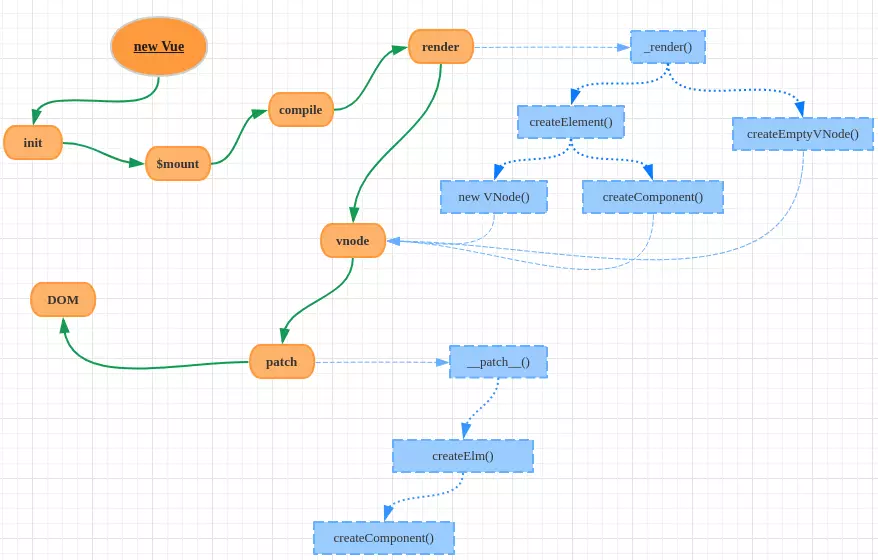# 简述
首先keep-alive是一个组件,但是它不会渲染dom,有三个属性参数include, exclude, max。分别代表着缓存白名单,缓存黑名单,以及缓存组件最大数。max的作用是当缓存组件超出max值时,可以优化缓存,让缓存以LRU最近最久未使用的策略去删除多余的组件
# 组件
keep-alive组件大致长这样
// src/core/components/keep-alive.js
export default {
name: 'keep-alive',
abstract: true, // 判断当前组件虚拟dom是否渲染成真实dom的关键
props: {
include: patternTypes, // 缓存白名单
exclude: patternTypes, // 缓存黑名单
max: [String, Number] // 缓存的组件
},
created() {
this.cache = Object.create(null) // 缓存虚拟dom
this.keys = [] // 缓存的虚拟dom的键集合
},
destroyed() {
for (const key in this.cache) {
// 删除所有的缓存
pruneCacheEntry(this.cache, key, this.keys)
}
},
mounted() {
// 实时监听黑白名单的变动
this.$watch('include', val => {
pruneCache(this, name => matched(val, name))
})
this.$watch('exclude', val => {
pruneCache(this, name => !matches(val, name))
})
},
render () {
const slot = this.$slots.default
const vnode: VNode = getFirstComponentChild(slot) // 找到第一个组件对象
const componentOptions: ?VNodeComponentOptions = vnode && vnode.componentOptions
if (componentOptions) { // 存在组件参数
// check pattern
const name: ?string = getComponentName(componentOptions) // 组件名
const { include, exclude } = this
if ( // 根据include,exclude条件匹配是否缓存数组,不缓存直接返回vnode组件实例
// not included
(include && (!name || !matches(include, name))) ||
// excluded
(exclude && name && matches(exclude, name))
) {
return vnode
}
const { cache, keys } = this
// 根据组件的id和tag定义组件的缓存key
const key: ?string = vnode.key == null
// 同一个构造函数可能会被注册为不同的本地组件,所以单独使用cid是不够的
? componentOptions.Ctor.cid + (componentOptions.tag ? `::${componentOptions.tag}` : '')
: vnode.key
if (cache[key]) { // 已经缓存过改组件
vnode.componentInstance = cache[key].componentInstance
// 让当前的key始终保持最优先,更新的原因是为了实现LRU置换策略
// LRU: 最近最少使用策略, 选择最近最久未使用的页面予以淘汰
// 假设缓存时发现超过了max缓存数量,则根据LRU删除最近最久未使用的实例(即是下标为0的那个key),因为当前活跃的缓存组件已经被更改到数组中的最后了
remove(keys, key) // 从缓存的虚拟dom键中删除key
keys.push(key) // 删除完又添加,也就是调整排序
} else {
// delay setting the cache until update
// 推迟设置缓存直到更新
this.vnodeToCache = vnode
this.keyToCache = key
}
// 将该组件实例的keepAlive属性设置为true
vnode.data.keepAlive = true // 渲染和执行被包裹组件的钩子函数需要用到
}
return vnode || (slot && slot[0])
}
}
# render函数的作用
- 首先找到keep-alive包裹的第一个组件对象
- 根据include和exclude条件匹配是否缓存组件
- 根据组件的cid和tag定义组件的缓存key,因为单独的cid并不能保持唯一性,同一个构造函数可能会被注册为不同的本地组件。根据key查找是否缓存了该组件,如果是取出组件更新位置,当前组件已经缓存过,则让该组件放到缓存数组中的最后一个,如果设置了
max属性,会因为LRU策略,删除下标为0(最近最久未使用)的组件。 - 设置当前组件
keepAlive属性为true,作用是可以让初始化生命周期时keep-alive不被渲染。
# 渲染
先看一张vue渲染导图

Vue的渲染时从render阶段开始的,但keep-alive的渲染是在patch阶段,这是构建组件树(虚拟dom树),并将vnode转化成DOM结点的过程。
简述从render到patch过程
从new Vue开始
import App from './App.vue'
new Vue({
render: h => h(App)
}).$mount('#app')
- Vue在渲染的时候先调用原型上的_render函数将组件对象转化成一个VNode实例;而_render是通过调用createElement和createEmptyVNode两个函数进行转化;
- createElement的转化过程会根据不同的情形选择new VNode或者调用createComponent函数做VNode实例化;
- 完成VNode实例化后,这时候Vue调用原型上的_update函数把VNode渲染成真实DOM,这个过程又是通过调用patch函数完成的(这就是patch阶段了)
# keep-alive组件的渲染
keep-alive不会生成真正的结点
// src/core/instance/lifecycle.js
export function initLifecycle (vm: Component) {
const options = vm.$options
// 找到第一个非abstract的父组件实例
// Vue在初始化生命周期的时候,为组件实例建立父子关系会根据abstract属性决定是否忽略某个组件
// 在keep-alive中,设置了abstract:true,那Vue就会跳过该组件实例
// 最后构建的组件树中就不会包含keep-alive组件
// 那么由组件树渲染成的DOM树自然也不会有keep-alive相关的节点了
let parent = options.parent
if (parent && !options.abstract) {
while (parent.$options.abstract && parent.$parent) {
parent = parent.$parent
}
parent.$children.push(vm)
}
}
# keep-alive包裹的组件是如何使用缓存的
// src/core/vdom/patch.js
function createComponent (vnode, insertedVnodeQueue, parentElm, refElm) {
let i = vnode.data
if (isDef(i)) {
const isReactivated = isDef(vnode.componentInstance) && i.keepAlive
if (isDef(i = i.hook) && isDef(i = i.init)) {
i(vnode, false /* hydrating */)
}
// 在调用init钩子之后,如果vnode是一个子组件,
// 它应该创建一个子实例并挂载它。 子组件还设置了占位符vnode的elm。
// 在这种情况下,我们只需要返回元素就可以了。
// 在首次加载被包裹组建时,由keep-alive.js中的render函数可知,
// vnode.componentInstance的值是undfined,keepAlive的值是true,
// 因为keep-alive组件作为父组件,它的render函数会先于被包裹组件执行;
// 那么只执行到i(vnode,false),后面的逻辑不执行;
// 再次访问被包裹组件时,vnode.componentInstance的值就是已经缓存的组件实例,
// 那么会执行insert(parentElm, vnode.elm, refElm)逻辑,
// 这样就直接把上一次的DOM插入到父元素中。
if (isDef(vnode.componentInstance)) {
initComponent(vnode, insertedVnodeQueue)
insert(parentElm, vnode.elm, refElm) // keep-alive将缓存的DOM(vnode.elem) 插入父元素中
if (isTrue(isReactivated)) {
reactivateComponent(vnode, insertedVnodeQueue, parentElm, refElm)
}
return true
}
}
}
# 只执行一次的钩子
// src/core/vdom/create-component.js
const componentVNodeHooks = {
init (vnode: VNodeWithData, hydrating: boolean): ?boolean {
if ( // 当组件的vnode.componentInstance和vnode.data.keepAlive同时存在时,就不进行$mount
// 过程,也就不会执行组件的所有钩子函数(beforeCreate、created、mounted等)
vnode.componentInstance &&
!vnode.componentInstance._isDestroyed &&
vnode.data.keepAlive
) {
// kept-alive components, treat as a patch
const mountedNode: any = vnode // work around flow
componentVNodeHooks.prepatch(mountedNode, mountedNode)
} else {
const child = vnode.componentInstance = createComponentInstanceForVnode(
vnode,
activeInstance
)
child.$mount(hydrating ? vnode.elm : undefined, hydrating)
}
},
}
# 可重复的activated
在patch的阶段,最后会执行invokelinsertHook函数,而这个函数就是去调用组件实例自身的insert钩子
// src/core/vdom/patch.js
function invokeInsertHook (vnode, queue, initial) {
if (isTrue(initial) && isDef(vnode.parent)) {
vnode.parent.data,pendingInsert = queue
} else {
for(let i =0; i<queue.length; ++i) {
queue[i].data.hook.insert(queue[i]) // 调用VNode自身的insert钩子函数
}
}
}
再看insert钩子:
const componentVNodeHooks = {
// init()
insert (vnode: MountedComponentVNode) {
const { context, componentInstance } = vnode
if (!componentInstance._isMounted) {
componentInstance._isMounted = true
callHook(componentInstance, 'mounted')
}
if (vnode.data.keepAlive) {
if (context._isMounted) {
queueActivatedComponent(componentInstance)
} else {
activateChildComponent(componentInstance, true/* direct */)
}
}
// ...
}
}
在这个钩子里面,调用了activateChildComponent函数递归地去执行所有子组件的activated钩子函数:
// src/core/instance/lifecycle.js
export function activateChildComponent (vm: Component, direct?: boolean) {
if (direct) {
vm._directInactive = false
if (isInInactiveTree(vm)) {
return
}
} else if (vm._directInactive) {
return
}
if (vm._inactive || vm._inactive === null) {
vm._inactive = false
for (let i = 0; i < vm.$children.length; i++) {
activateChildComponent(vm.$children[i])
}
callHook(vm, 'activated')
}
}
相反地,deactivated钩子函数也是一样的原理,在组件实例(VNode)的destroy钩子函数中调用deactivateChildComponent函数。